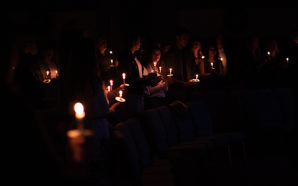The Mass of the Holy Oils (or Chrism Mass) celebrated during Holy Week has a long and complex history. The oils blessed and consecrated during the liturgy are associated with ancient rituals of anointing used across various religious traditions as symbols of identification, strengthening, healing and sanctification.
Historical Background
In the Old Testament, kings (e.g. 1 Sam. 10:1; 16:13), priests (e.g. Lev. 8:12, 30) and prophets were normally anointed with the oil of consecration as a sign of their office or duty. They came to prefigure Christ, whose name is derived from the Greek word Christos meaning “anointed of the Lord”. Later New Testament sources refer to the anointing of the sick with oil (cf. Mark 6:13; James 5:14) accompanying prayers to God for healing and forgiveness. Some early Church sources (e.g. Hippolytus, c. 215CE) describe catechumens being anointed with oil accompanying prayers for strength during their conversion to Christ and the Gospel prior to Baptism. After Baptism, the anointing of neophytes with aromatic chrism (Gk. myron) came to be associated with the reception of the gifts of the Spirit, perhaps owing to the chrism’s “odour of sanctity”.
Around the fourth century, it seems that chrism (comprising oil and an aromatic resin called balsam) was initially consecrated by the bishop during the Easter Vigil for use during the baptismal liturgy. After priests were deputed to celebrate the rites of Christian initiation in local communities on Holy Saturday, however, it was necessary to consecrate chrism at the next earliest time, namely, the Mass of the Lord’s Supper on Holy Thursday as there was no celebration of the Eucharist on Good Friday. The practice of consecrating chrism after Communion on Holy Thursday continued in the Roman Rite until the reforms of Holy Week in 1955-6.
Some early Church sources also point to separate prayers of blessing for the oil of catechumens and of the sick. By the seventh century in northern European churches, these prayers were added to the consecration of chrism and eventually included in a separate Mass on Holy Thursday morning, a practice continued today by the Pope at the Basilica of St John Lateran in Rome and in other dioceses. In other places, the Mass of the Holy Oils is generally celebrated earlier in Holy Week (e.g. Tuesday) for the benefit of clergy who need to travel considerable distances in many cases, and due to their preparations for the liturgy on Holy Thursday evening.
After the liturgical reforms of the Second Vatican Council (1962-1965), Pope St Paul VI approved changes to the Chrism Mass. Because of the strong association of the holy oils with the sacramental ministry of priests, and the celebration of the Chrism Mass on Holy Thursday when the Church teaches that Christ instituted the Eucharist and core components of the Church’s priestly ministry, Paul VI approved the addition of a rite, after the homily, of the annual renewal of priestly commitment.
Theological Themes
The Chrism Mass brings together several rich and important themes. For example, the rubrics highlight the communion between the bishop, as high priest of the local Church community and the diocesan clergy. The scripture readings (Isaiah 61:1-3a, 6, 8b-9; Revelation 1:5-8 and Luke 4:16-21) remind those present of the purposes of Jesus’ anointing by the Spirit, in fulfillment of the prophet Isaiah, namely: to preach the good news to the poor, to proclaim liberty to captives, to give new sight to the blind and freedom to the downtrodden and to proclaim the Lord’s year of favour. Finally, the liturgical prayers (especially the Preface) connect Christ’s anointing by the Spirit with the royal priesthood of God’s holy people, a number of whom are ordained to share Christ’s sacred ministry.
The blessing of the oils of the catechumens and the sick and the consecration of chrism for rites of anointing during the Church’s rites and sacraments, the consecration of altars and dedication of churches is significant when celebrated close to the Easter Triduum. These sacramental actions are intimately connected with the ministry of the ordained in service of the faithful, and the anointing with chrism links the ministry of the priests to that of the bishop. The rituals mark important liturgical symbols in the Church with signs of Christ’s presence and foster reflection upon participation in Christ’s paschal mystery, celebrated with heightened solemnity during the paschal feasts.
Mindful of the rich commentaries that have appeared since the Council regarding the significance of baptism into Christ’s body the Church, the responsibilities of the ordained in relation to the baptised within Christ’s royal priesthood and all God’s people, and the important participation of all priests, ministers and the faithful during the Celebration of the Eucharist, increasing opportunities have been provided during the Chrism Mass for clergy, religious and laity to renew their respective commitments to the service of Christ and the Church.
Pastoral Considerations
The pastoral issues associated with the Mass of the Holy Oils include the question of convenient timing in relation to Easter ceremonies, finding ways to provide for a range of diocesan representatives to attend and participate in significant ways in the liturgy, logistics regarding provision of sufficient oils (either centrally by the Cathedral community or by representatives from parishes) and identifying a suitable place of honour (called an “aumbry”) in parish churches for enshrining the vessels containing the holy oils.
The Australian Catholic Bishops Conference guidelines on liturgical space entitled And When Churches are to Be Built: Preparation, Planning and Construction of Places of Worship (Liturgy Brisbane, 2014) advise that the most common location for the aumbry containing the holy oils is near the font (no. 398), for two of the oils – the oil of catechumens and the holy chrism – are used during the sacraments of Christian Initiation.
The Mass of the Holy Oils provides the bishop, priests, deacons, religious and laity who can attend with a wonderful opportunity to be touched again by the presence of Christ, to renew their commitment to participation in Christ’s paschal mystery and priesthood, and to furnish parish communities with the holy oils. The Mass can underscore the traditional biblical rites of anointing and service of God, with the ministry of the bishop as Christ’s chief shepherd in the diocese in collaboration with the local priests and deacons and, by virtue of their common anointing through baptism and confirmation, the ministries of religious and laity. The anointing with chrism calls all who minister to exude the “pleasing fragrance of Christ” (Prayer after Communion).
Paul Taylor is Organist and Director of Music at Sacred Heart Cathedral, Bendigo and Executive Secretary of the Bishops Commission for Liturgy of the Australian Catholic Bishops Conference.
Reproduced with permission.








